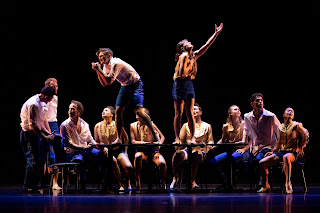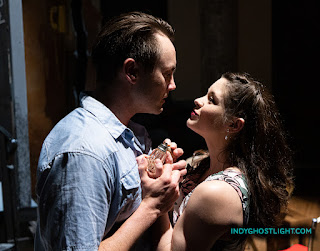DK's 'Divas A-New': What's past is prologue (so is what's present)
 |
| Ensemble exuberance in "Stories from the Corner Bar" |
Joshua Blake Carter's curtain speech gave Dance Kaleidoscope's opening-night audience Thursday a concise, graceful indication of how the transition from his illustrious predecessor as artistic director, David Hochoy, is settling in.
Before "Divas A-New" took the stage, the audience at Schrott Center for the Arts (a new venue for the company) got brief exposure to DK's educational wing as two student troupes performed. That was a charming showcase for what's been possible since DK moved into a new permanent rehearsal and educational home in 2020. The solidity of the professional company no longer had to pose questions as to whether its growing profile was anything more than a castle in the air.
Setting aside what the hyphen in the program title must mean (since "anew" would seem to convey the idea), it's clear the "divas" idea builds upon the popular focus in earlier programs on top female singers as the springboard to new works. The program is divided evenly between pieces by Hochoy and Carter. The signal of continuity is unmistakable; there's an unspoken regard for legacy, too, in two cases.
"Stories from the Corner Bar," Carter's new piece using Brandi Carlile's music, carries a reminder that she helped hold up the contributions of Joni Mitchell to the singer-songwriter tradition by befriending Mitchell and bringing her back into the public eye after her recovery from a brain aneurysm in 2015. And a rare DK encore, Carter's hard-charging setting of "River Deep, Mountain High," is evidently a memorial tribute to another diva, Tina Turner, who died last May.
The first half's diva is Ella Fitzgerald, whose first name as the piece's title proclaims the iconic status of this peerless interpreter of the Great American Songbook. Hochoy's "Ella" (2015) is set to eight songs, with romantic costuming by Guy Clark and lighting (by Laura E. Glover) that provides the haloed atmosphere Fitzgerald's songbook recordings represent so well. The piece has a rounded quality, as "With a Song in My Heart" returns at the end to the calm reflectiveness of the opening song, "Night and Day."
 |
| "Tea for Two" as an embarrassment of choices |
Finally, I continue to be impressed with the range of DK's senior member, Paige Robinson. She carried the heartrending payback message of "Cry Me a River" as the central figure of three dancers (Harkins and Marie Kuhns were the others). Thinking back on her portrayal of the Mother in Hochoy's "China Boy" last year, it's obvious she's become DK's foremost tragedienne. Yet it was fitting in the very next song, "Oh, Lady Be Good," that she had the first solo in Ella's marvelous succession of scat choruses, in which Hochoy's always durable sense of humor comes to the fore. Her expressive spectrum seems limitless. And her work so far under the new artistic director bears this out, as "Stories from the Corner Bar" confirmed.
 |
| Adrian Dominguez, Julie Russel in "Turpentine" |
The world premiere made unmistakable Carter's affinity for nondance energies that can be turned to artistic ends. He asks for relationships to form and dissolve with the naturalness of our divided minds in social settings. He requires a few group vocalizations of relief, laughter and triumph. He has couples mimic conversations to the side of the main focus, as actors in plays are often called upon to do in group scenes.
[Photos by Lora Olive and Freddie Kelvin]



Comments
Post a Comment